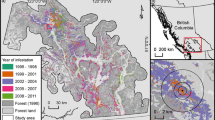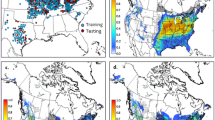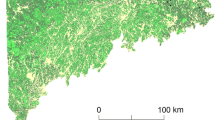Abstract
An invasive forest pathogen, Cronartium ribicola, white pine blister rust (WPBR), is believed to have arrived in the Sacramento Mountains of south-central New Mexico about 1970. Epidemiological and genetic evidence supports the hypothesis that introduction was the result of long-distance dispersal (LDD) by atmospheric transport from California. This study applies a method to identify the atmospheric conditions favorable for rust transport and infection. An upper level synoptic classification (ULSC) identifies patterns of upper-level flow favorable for the transport of rust spores from a source to a target. Transport data are coupled with data for surface conditions favorable for infection at a designated target. A resulting calendar lists likelihood classes for establishment by four-times-daily observations during a dispersal season from April through July in the years 1965 to 1974. The single most-favorable period for transport and infection at the New Mexico site was identified as 1–15 June 1969. Five additional sites in the western United States with susceptible white pine populations and known infestation status were then evaluated to verify the model. Only the infested sites exhibit an establishment likelihood of “high” or “very high.” This suggests that the methodology correctly identifies locations with elevated establishment likelihood. Finally, likelihoods at nine additional points in the southwestern United States are determined and used to map regional patterns of transport, infection and establishment. The ULSC combined with appropriate surface meteorological data could be used to further investigate transport and infection, identify other areas at risk, assess the potential for gene flow of WPBR and evaluate long-distance dispersal of other pathogens.




Similar content being viewed by others
References
Andow DA, Kareiva PM, Levin SA, Okubo A (1990) Spread of invading organisms. Landscape Ecol 4:177–188
Aylor DE (1986) A framework for examining inter-regional aerial transport of fungal spores. Agric For Meteorol 38:263–288
Aylor DE (2003) Spread of plant disease on a continental scale: role of aerial dispersal of pathogens. Ecology 84(8):1989–1997
Blodgett JT, Sullivan KF (2004) First report of white pine blister rust on Rocky Mountain bristlecone pine. Plant Dis 88:311
Bowden J, Gregory PH, Johnson CG (1971) Possible wind transport of coffee leaf rust across the Atlantic Ocean. Nature 229:500–501
Brown JKM, Hovmoller MS (2002) Aerial dispersal of pathogens on the global and continental scales and its impact on plant disease. Science 297(5581):537–541
Bureau of Plant Industry (1921) Annual report for 1921 on the white pine blister rust work in the Far West. Unnumbered report. U.S. Department of Agriculture, Berkeley, CA, p 25
Caswell H, Lensink R, Neubert MG (2003) Demography and dispersal: life table response experiments for invasion speed. Ecology 84(8):1968–1978
Clark JS, Lewis M, McLachlan JS, HilleRisLambers J (2003) Estimating population spread: what can we forecast and how well? Ecology 84(8):1979–1988
Conklin DA (2004) Development of the white pine blister rust outbreak in New Mexico. Rep. R3-04-01. Albuquerque, NM: U.S. Department of Agriculture, Forest Service, Southwest Region. 11 p. Online:http://www.fs.fed.us/r3/publications/documents/wp_blister_rust_nm.pdf. [Accessed October 17, 2006]
Davis JM, Monahan JF (1991) Climatology of air parcel trajectories related to the atmospheric transport of Peronospora tabacina. Plant Dis 75:706–711
Draper MA, Walla JA (1993) First report of Cronartium ribicola in North Dakota. Plant Dis 77:952
Frank KL, Geils BW, Kalkstein LS, Thistle HW Jr (2008) Synoptic climatology of the long-distance dispersal of white pine blister rust. I. Development of an upper level synoptic classification. Int J Biometorol (this issue)
Fujioka FM (1996) Climatic factors that influence the spread of white pine blister rust. In: Kinloch BB Jr, Marosy M, Huddleston ME (eds) Sugar pine: status, values and roles in ecosystems, proceeding of a symposium presented to the California Sugar Pine Management Committee. Pub 3362. University of California, Division of Agriculture and Natural Resources, Davis, CA, pp 119–124
Geils BW (2000) Establishment of white pine blister rust in New Mexico. HortTechnology 10(3):528–529
Geils BW (2001) Impacts of white pine blister rust. In: Fosbroke SLC, Gottschalk KW (eds) Proceedings, U.S. Department of Agriculture interagency research forum on gypsy moth and other invasive species 2001; 2001 January 16–19; Annapolis MD. Gen Tech Rep NE-285. U.S. Department of Agriculture, Forest Service, Northeastern Research Station, Newton Square, Pennsylvania
Geils BW, Conklin D, Frank K, Guyon J, Harris JL, Hoffman J, Jacobi W, Kearns H, Newcomb M, Smith E, Van Arsdel E, Vogler D (2003) New information on the distribution of white pine blister rust for 2002. In: Stone J, Maffei H (eds). Proceedings of the 50th Western International Forest Disease Work Conference; 2002 October 7–11; Powell River, BC. U.S. Department of Agriculture, Forest Service, Central Oregon Service Center, Bend, OR
Hamelin RC, Hunt RS, Geils BW, Jensen GD, Jacobi V, Lecours N (2000) Barrier to gene flow between eastern and western populations of Cronartium ribicola in North America. Phytopathology 90:1073–1078
Hawksworth FG (1990) White pine blister rust in southern New Mexico. Plant Dis 74:938
Hunt RS (2003) White pine blister rust. Recent Res Dev Mycol 1(2003):73–85
Isard SA, Gage SH, Comtois P, Russo JM (2005) Principles of the atmospheric pathway for invasive species applied to soybean rust. BioScience 15(10):851–861
Kalnay E, Kanamitsu M, Kistler R, Collins W, Deaven D, Gandin L, Iredell M, Saha S, White G, Woollen J, Zhu Y, Chelliah M, Ebisuzaki W, Higgins W, Janowiak J, Mo KC, Ropelewski C, Wang J, Leetmaa A, Reynolds R, Jenne R, Joseph D (1996) The NCEP/NCAR reanalysis 40-year project. Bull Am Meteorol Soc 77:437–471
Kearns HSJ (2005) White pine blister rust in the central Rocky Mountains: Modeling current status and potential impacts. Dissertation. Colorado State University, Fort Collins, Colorado
Kliejunas J (1985) Spread and intensification of white pine blister rust in the southern Sierra Nevada. Phytopathology 75:1367
Kliejunas J (2002) An update on the southern extent of white pine blister rust in California. Rep R02-01. U.S. Department of Agriculture, Forest Service, Pacific Southwest Region, State and Private Forestry, Forest Health Protection, Vallejo, CA
Lundquist JE, Geils BW, Johnson DW (1992) White pine blister rust on limber pine in South Dakota. Plant Dis 76:538
Mack RN, Simberloff D, Lonsdale WM, Evans H, Clout M, Bazzaz F (2000) Biological invasions: causes, epidemiology, global consequences and control. Issues in Ecology 5, Ecological Society of America, Washington, D.C.
Mielke JL (1943) White pine blister rust in western North America. Bulletin 52. Yale University, School of Forestry, New Haven, CT
Mims SA, Mims FM (2004) Fungal spores are transported long distances in smoke from biomass fires. Atmos Environ 38(5):651–655 DOI 10.1016/j.atmosenv.2003.10.043
Munoz J, Felicisimo AM, Cabezas F, Burgaz AR, Martinez I (2004) Wind as a long-distance dispersal vehicle in the Southern Hemisphere. Science 304:1144–1147
Muller-Landau HC, Levin SA, Keymer JE (2003) Theoretical perspectives on evolution of long-distance dispersal and the examples of specialized pests. Ecology 84(8):157–167
Nagarajan S, Singh DV (1990) Long-distance dispersal of rust pathogens. Annu Rev Phytopathol 28:139–153
NESCIS (2003) TD-3200 Cooperative summary of the day. U.S. Department of Commerce, Washington, D.C.
NOAA-CIRES Climate Diagnosis Center (2002) http://www.cdc.noaa.gov/cdc/data.ncep.reanalysis.html. [Accessed 12 March 2002]
Purdy LH, Krupa SV, Dean JL (1985) Introduction of sugarcane rust into the Americas and its spread to Florida. Plant Dis 69:689–693
Samman S, Schwandt JW, Wilson JL (2003) Managing for healthy white pine ecosystems in the United States to reduce the impacts of white pine blister rust. Rep R1-03-118. U.S. Department of Agriculture, Forest Service, Missoula, Montana
Seem RC, Magarey RD, Zack JW, Russo JM (2000) Estimating disease risk at the whole plant level with General Circulation Models. Environ Pollut 108(3):389–395
Smith JP, Hoffman JT (2000) Status of white pine blister rust in the Intermountain West. West N Am Nat 60(2):165–179
UCAR (2003) NCEP/NCAR Reanalysis > Project Description. http://dss.ucar.edu/pub/reanalysis/rean_proj_des.html. [accessed August 4, 2003], April 1
Van Arsdel EP (1967) The nocturnal diffusion and transport of spores. Phytopathology 57:1221–1229
Van Arsdel EP (1973) Origin of south Texas peanut rust epidemics. In: Calpouzos L, Campos A (coords) Symposium on the aerobiology of diseases, pests, and allergens in the Western hemisphere. Science and Man in the Americas. June 20–July 4, 1973
Van Arsdel EP, Geils BW (2004) The Ribes of Colorado and New Mexico and their rust fungi. Rep. FHTET 04-13. Fort Collins, CO: U.S. Department of Agriculture, Forest Service, Forest Health Technology Enterprise Team.
Van Arsdel EP, Riker AJ, Kouba TF, Suomi VE, Bryson RA (1961) The climatic distribution of blister rust on white pine in Wisconsin. Station Paper 87. U.S. Department of Agriculture, Forest Service, Lake States Experiment Station, St. Paul, MN
Van Arsdel EP, Conklin DA, Popp JB, Geils BW (1998) The distribution of white pine blister rust in the Sacramento Mountains of New Mexico. In: Jalkanen R, Crane PE, Walla JA, Aalto T (eds) Proceedings of the 1st IUFRO rusts of forest trees working party conference; 1998 August 2–7; Saariselkä, Finland. Research Paper 712. Finnish Forest Research Institute, Rovaniemi, Finland
Van Arsdel EP, Geils BW, Zambino PJ (2006) Epidemiology for hazard rating of white pine blister rust. In: Guyon, J (comp) Proceedings of the 53rd Western International Forest Disease Work Conference; 2005 August 26–29; Jackson, Wyoming. U.S. Department of Agriculture, Forest Service, Intermountain Region, Ogden, UT
Vogler DR, Charlet DA (2004) First report of the white pine blister rust fungus (Cronartium ribicola) infecting whitebark pine (Pinus albicaulis) and Ribes spp. in the Jarbidge Mountains of northeastern Nevada. Plant Dis 88:772
Waggoner PE, Aylor DE (2000) Epidemiology: a science of patterns. Annu Rev Phytopathol 28:71–94
Yonow T, Kriticos DJ, Medd RW (2004) The potential geographic range of Pyrenophora semeniperda. Phytopathology 94:805–812
Acknowledgments
The authors thank Frank Hawksworth for finding the rust; Gene Van Arsdel for insisting it came from California; Dave Conklin and John Popp for showing us where it was; Mary Lou Fairweather for challenging us to explain why not the San Francisco Peaks; Detlev Vogler for encouraging us to see it as a dynamic, interacting, and evolving member of a complex pathosystem; Paul Zambino for comments on the manuscript; and Richard Sniezko for sharing Danchock’s find. This work was funded by the United States Department of Agriculture, Forest Service, Forest Health Protection, Forest Health Technology Enterprise Team Project# TD.01.M01 and Rocky Mountain Research Station (03-JV-11221605-297), and University of Delaware, Department of Geography, Center for Climatic Research. Development of the ULSC and its application to the Sacramento outbreak was performed by Katrina Frank in partial fulfillment of a Ph.D. in Climatology.
Author information
Authors and Affiliations
Corresponding author
Rights and permissions
About this article
Cite this article
Frank, K.L., Geils, B.W., Kalkstein, L.S. et al. Synoptic climatology of the long-distance dispersal of white pine blister rust II. Combination of surface and upper-level conditions. Int J Biometeorol 52, 653–666 (2008). https://doi.org/10.1007/s00484-008-0158-3
Received:
Revised:
Accepted:
Published:
Issue Date:
DOI: https://doi.org/10.1007/s00484-008-0158-3




